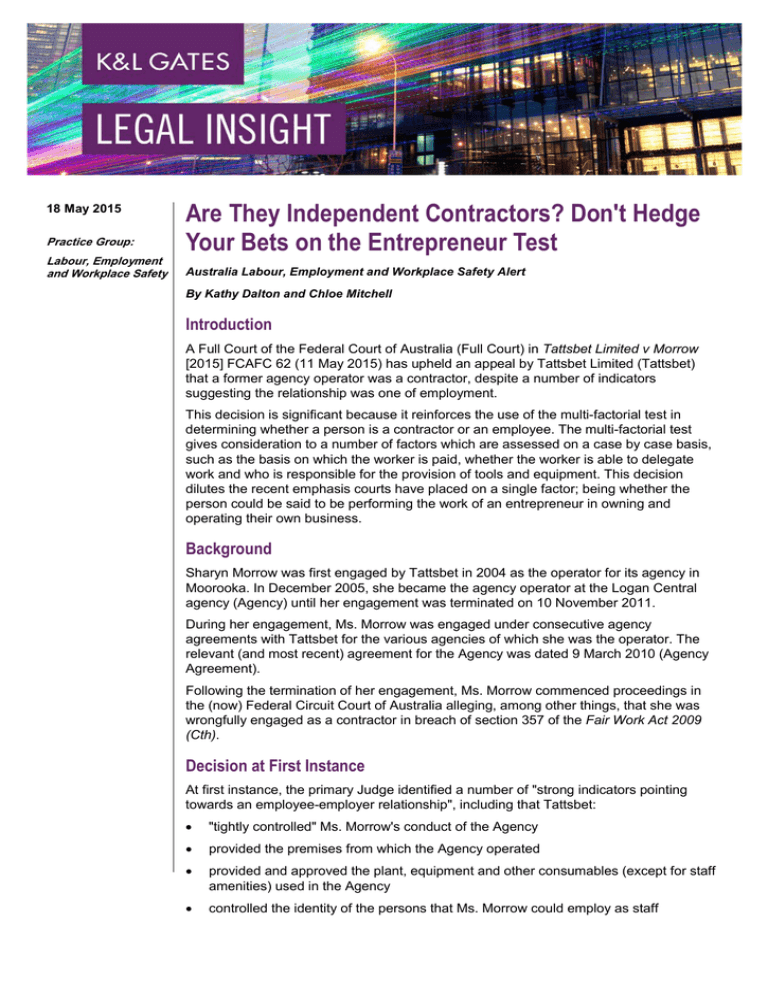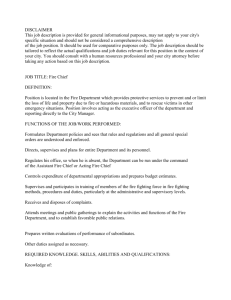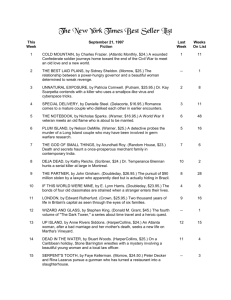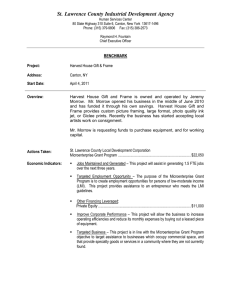
18 May 2015
Practice Group:
Labour, Employment
and Workplace Safety
Are They Independent Contractors? Don't Hedge
Your Bets on the Entrepreneur Test
Australia Labour, Employment and Workplace Safety Alert
By Kathy Dalton and Chloe Mitchell
Introduction
A Full Court of the Federal Court of Australia (Full Court) in Tattsbet Limited v Morrow
[2015] FCAFC 62 (11 May 2015) has upheld an appeal by Tattsbet Limited (Tattsbet)
that a former agency operator was a contractor, despite a number of indicators
suggesting the relationship was one of employment.
This decision is significant because it reinforces the use of the multi-factorial test in
determining whether a person is a contractor or an employee. The multi-factorial test
gives consideration to a number of factors which are assessed on a case by case basis,
such as the basis on which the worker is paid, whether the worker is able to delegate
work and who is responsible for the provision of tools and equipment. This decision
dilutes the recent emphasis courts have placed on a single factor; being whether the
person could be said to be performing the work of an entrepreneur in owning and
operating their own business.
Background
Sharyn Morrow was first engaged by Tattsbet in 2004 as the operator for its agency in
Moorooka. In December 2005, she became the agency operator at the Logan Central
agency (Agency) until her engagement was terminated on 10 November 2011.
During her engagement, Ms. Morrow was engaged under consecutive agency
agreements with Tattsbet for the various agencies of which she was the operator. The
relevant (and most recent) agreement for the Agency was dated 9 March 2010 (Agency
Agreement).
Following the termination of her engagement, Ms. Morrow commenced proceedings in
the (now) Federal Circuit Court of Australia alleging, among other things, that she was
wrongfully engaged as a contractor in breach of section 357 of the Fair Work Act 2009
(Cth).
Decision at First Instance
At first instance, the primary Judge identified a number of "strong indicators pointing
towards an employee-employer relationship", including that Tattsbet:
•
"tightly controlled" Ms. Morrow's conduct of the Agency
•
provided the premises from which the Agency operated
•
provided and approved the plant, equipment and other consumables (except for staff
amenities) used in the Agency
•
controlled the identity of the persons that Ms. Morrow could employ as staff
Are They Independent Contractors? Don't Hedge Your Bets on the
Entrepreneur Test
•
reserved to itself the right to approve any proposed leave of absence
•
reimbursed Ms. Morrow for payroll tax for her own employees for at least some
period of time.
Further, Ms. Morrow was:
•
required to purchase the relevant supplies from Tattsbet
•
unable to make autonomous decisions about the conduct of the betting services that
were provided through the Agency or the conduct of the Agency business generally
•
required to seek approval from Tattsbet in relation to any promotional activities she
undertook.
Initially in his judgment, the primary Judge made reference to the multi-factorial test
where all relevant circumstances needed to be weighed and the totality of the
relationship identified as set out in Stevens v Brodribb Sawmilling Co Pty Ltd (1985) 160
CLR 16, Hollis v Vabu Pty Ltd (2001) 207 CLR 21 and Ace Insurance v Trifunovksi
(2013) 209 FCR 146. However, His Honour proceeded to apply the 'test' adopted by
Justice Bromberg in On Call Interpreters & Translators Agency Pty Ltd v Commisionner
of Taxation (No 3) (2011) 214 FCR 82 (On Call Interpreters) where Justice Bromberg
stated:
"Simply expressed the question of whether a person is an independent contractor in
relation to the performance of particular work, may be posed and answered as
follows.
Viewed as a 'practical matter':
(i) is the person performing the work [of] an entrepreneur who owns and operates a
business? and
(ii) in performing the work, is that person working in and for that person's business
as a representative of that business and not of the business receiving the work?"
Justice Bromberg in On Call Interpreters stated that if the answer is 'yes', the person is
likely to be an independent contractor in the performance of that particular work.
While the primary Judge remarked that there was no single decisive factor and it was a
"finely balanced case", he stated that he was left with the overall impression that Ms.
Morrow was working in Tattsbet's business rather than in her own and, on this basis, she
was an employee.
Full Court Decision
In Tattsbet's appeal against the decision of the primary Judge, the Full Court (Chief
Justice Allsop and Justices Jessup and White) rejected the application of the test in On
Call Interpreters, acknowledging that the correct approach (the multi-factorial test) had
been identified by the primary Judge, but he had departed from it when deciding the
case.
The Full Court determined that the application of the test in On Call Interpreters was too
narrow and that the relevant question was not whether a person is an entrepreneur, but
whether he or she is an employee.
Their Honours noted that, insofar as Ms. Morrow's actual work at the Agency was
concerned, there would have been little distinction between her position and that of an
2
Are They Independent Contractors? Don't Hedge Your Bets on the
Entrepreneur Test
employee manager, however the Full Court ultimately determined that the following
features, in combination, compelled the conclusion that Ms. Morrow was a contractor.
•
The Agency Agreement in which Ms. Morrow expressly acknowledged that she was
an independent contractor. The Full Court found this was significant in this case to
the extent that it clearly reflected the real intentions of Ms. Morrow as to the reality of
the relationship. The Agency Agreement was the fourth in a line of similarly worded
agreements and the Full Court found that there could be no suggestion that Ms.
Morrow did not clearly appreciate the distinction between being an employee and
being an independent contractor. The Full Court held that the relationship was
agreed to by Ms. Morrow and this was supported by the circumstantial facts,
including that Ms. Morrow had structured her arrangements so that they conformed
with that of a business operator.
•
Ms. Morrow was not engaged or paid for her work alone (which might not be
distinguishable from that of an employee). Her engagement was to operate the
Agency and she was paid according to the value of the transacted business. She was
not required to perform all the work herself and was free to employ others.
•
Ms. Morrow employed staff, was active in her employer's association membership
and entered into an enterprise agreement with her employees. While these were
indicative factors in favour of a contractor relationship, the Chief Justice commented
that the employment of staff, while significant, cannot be taken for all purposes and
circumstances as a determining factor against being an employee.
•
Ms. Morrow's net personal income was approximately one-third of the gross
remuneration she received for operating the Agency. The Full Court noted that where
there is a greater divergence between the overall remuneration to the person and his
or her personal net income, it will be harder to conclude that the essence of what is
being paid for is the work and skill of a person (being the essence of employment).
•
The Full Court also found that the time and resources allocated by Ms. Morrow in
meeting her regulatory obligations in relation to the Goods and Services Tax (GST)
was relevant as it was inconsistent with her claim that she was an employee.
Significance of the Full Court Decision
The decision of the Full Court confirms that the correct test to apply in determining
whether a person is an employee or a contractor remains the multi-factorial test. On this
basis, no singular factor or simply expressed notion, such as whether a person is working
in their own business or the business of someone else, will determine employee status.
Similarly, employment of others will not, of itself, be determinative of a contractor
relationship.
It is yet another reminder that drawing the distinction between employees and contractors
is not clear and simple, and that careful consideration of the specific circumstances
should be given in the engagement of contractors.
Authors:
Kathy Dalton
kathy.dalton@klgates.com
+61.3.9640.4232
3
Are They Independent Contractors? Don't Hedge Your Bets on the
Entrepreneur Test
Chloe Mitchell
chloe.k.mitchell@klgates.com
+61.3.9640.4421
Anchorage Austin Beijing Berlin Boston Brisbane Brussels Charleston Charlotte Chicago Dallas Doha Dubai Fort Worth Frankfurt
Harrisburg Hong Kong Houston London Los Angeles Melbourne Miami Milan Moscow Newark New York Orange County Palo Alto
Paris Perth Pittsburgh Portland Raleigh Research Triangle Park San Francisco São Paulo Seattle Seoul Shanghai Singapore
Spokane Sydney Taipei Tokyo Warsaw Washington, D.C. Wilmington
K&L Gates comprises more than 2,000 lawyers globally who practice in fully integrated offices located on five
continents. The firm represents leading multinational corporations, growth and middle-market companies,
capital markets participants and entrepreneurs in every major industry group as well as public sector entities,
educational institutions, philanthropic organizations and individuals. For more information about K&L Gates or
its locations, practices and registrations, visit www.klgates.com.
This publication is for informational purposes and does not contain or convey legal advice. The information herein should not be used or relied upon
in regard to any particular facts or circumstances without first consulting a lawyer.
© 2015 K&L Gates LLP. All Rights Reserved.
4




